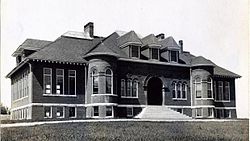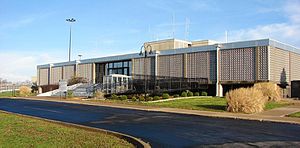IBM System p
IBM System p 시스템 p5 595 | |
| 로도 알려져 있다. | eServer pSeries(2000-2004) eServer p5(2004-2005) 시스템 p5(2005-2007) 시스템 p(2007-2008) |
|---|---|
| 개발자 | IBM |
| 유형 | 서버 |
| 출시일자 | 2000 |
| 중단됨 | 2008년 4월 ( |
| CPU | IBM Power 또는 PowerPC |
| 전임자 | IBM RS/6000 |
| 후계자 | IBM Power Systems |
| 관련기사 | IBM System i |
IBM System p는 RISC(Power)/UNIX 기반 서버의 고급 라인이다.RS/6000 라인의 후계자였으며, IBM Power Systems 서버 시리즈의 전신이었다.
역사
이전의 RS/6000 라인은 원래 워크스테이션과 서버 라인이었습니다.첫 번째 System p 서버 라인은 e-Server 브랜드 이니셔티브의 일환으로 2000년에 eServer pSeries로 명명되었다.
2004년에는 POWER5 프로세서의 등장으로 서버 제품군이 eServer p5로 재브랜드되었다.[1]
2005년, IBM의 전 세계 서버 및 스토리지 브랜드 합리화 움직임에 따라, 시스템 어젠다에 "시스템" 브랜드를 통합한 이후, 패밀리는 다시 시스템 p5로 개명되었다.System p5는 이제 IBM OpenPower 제품군을 포함했다.
2007년 POWER6 프로세서 모델의 도입 후 System p 브랜드에 의한 마지막 개명은 p(number) 지정을 삭제했다.
2008년 4월, IBM은 System p의 리브랜딩과 중거리 System i 플랫폼과의 통합을 발표했다.그 결과 생산 라인은 IBM Power Systems라고 불렸다.
하드웨어 및 소프트웨어
프로세서
이전의 RS/6000 라인은 초기 POWER와 PowerPC 프로세서를 혼합하여 사용한 반면, pSeries가 출시되었을 때 이는 전반적으로 RS64-III와 POWER3으로 진화했다.뛰어난 부동소수 성능의 POWER3와 확장성, 처리량, 정수 성능의 RS64.
IBM은 POWER3와 RS64 라인을 모두 대체할 POWER4 프로세서를 2001년에 개발했다.그 후, 처리량과 숫자의 크런치 최적화 시스템의 차이는 더 이상 존재하지 않았다.그 이후로 System p 기계는 POWER5를 사용하면서도 파워를 사용하도록 진화하였다.로우엔드 및 블레이드 시스템용 PC 970
마지막 System p 시스템은 POWER6 기반 System p 570 및 JS22 블레이드와 같은 POWER6 프로세서를 사용했다.또한 IBM은 리노에서 열린 슈퍼컴퓨팅 2007(SC07) 컨퍼런스에서 POWER6 코어 32개를 4.7GHz, 수냉이 최대 256GB RAM을 탑재한 POWER6 기반 System p 575를 새로 선보였다.
특징들
모든 IBM System p5 및 IBM eServer p5 머신은 Virtual I/O 및 Micro-partitioning을 사용한 DLPAR(Dynamic Logical Partitioning)을 지원한다.
System p는 일반적으로 AIX 운영 체제와 최근에는 Linux 운영 체제의 64비트 버전을 사용한다.
모델
BladeCenter
- IBM BladeCenter JS12(POWER6)
- IBM BladeCenter JS22(POWER6)
- IBM BladeCenter JS23(POWER6)
- IBM BladeCenter JS43(POWER6)
본선
eServer pSeries
- IBM eServer pSeries 610(7028-6C1 & 6E1)
- IBM eServer pSeries 615(7029-6C3, 7029-6E3)(1-2 코어 POWER4+ CPU)[2]
- IBM eServer pSeries 620(7025-F80, 6F0 & 6F1)(1~3개의 2코어 RS64-IV CPU)[3]
- IBM eServer pSeries 630(7028-6C4, 7028-6E4)(1코어 POWER4 CPU 또는 1~2코어 POWER4 CPU)[4]
- IBM eServer pSeries 640(7026-B80) 1-4 POWER3-II CPU
- IBM eServer pSeries 650(7038-6M2) POWER4 CPU 2-8개
- IBM eServer pSeries 655(7039-651) 4-8 POWER4 CPU
- IBM eServer pSeries 660(7026-H80, 6H0, 6H1, M80 & 6M1)
- IBM eServer pSeries 670(7040-671) 4-16 POWER4 CPU
- IBM eServer pSeries 680(7017 범위)
- IBM eServer pSeries 690(7040-681) 8-32 POWER4 CPU
2001년 말 출시 당시 IBM p690은 POWER4 프로세서 시대 IBM의 고급 유닉스 서버의 대표주체였다.일부 POWER4 특화 기능에서 Linux 버전을 실행할 수는 있지만 IBM AIX 유닉스를 실행하기 위해 구축되었다.
최대 32개(1.5, 1.7, 1.9GHz) POWER4+ 프로세서와 1000kg이 훨씬 넘는 1TB RAM을 지원할 수 있다.2004년 Forschungszentrum Jülich의 슈퍼 컴퓨터에서 사용되었으며, 2005년 말 단종되었다.[5]
eServer p5
2004년 개봉.[6]
- IBM eServer p5 510 Express(9111-510)(1-2 코어 1.5)GHz POWER5 CPU)[7][8]
- IBM eServer p5 510(9111-510)(1~2-core 1.65GHz POWER5 CPU)[9][8]
- IBM eServer p5 520 Express(9111-520)(1-2 코어 1.5)GHz POWER5 CPU)[10][11]
- IBM eServer p5 520(9111-520)(2-core 1.65GHz POWER5 CPU)[12][11]
- IBM eServer p5 550 Express(9113-550)(1-2 코어 1.5)GHz POWER5 CPU)[13][14]
- IBM eServer p5 550(9113-550)(1~2개의 2코어 1.65GHz POWER5 CPU)[15][14]
- IBM eServer p5 570 Express(9117-570)(1~8개의 2코어 1.5)GHz POWER5 CPU)[16][17]
- IBM eServer p5 570(9117-570)(1~8개의 2코어 1.65GHz 또는 1.9)GHz POWER5 CPU)[18][17]
- IBM eServer p5 590(9119-590)(8-core 1.65GHz POWER5 MCM 1~4개)[19][20]
- IBM eServer p5 595(9119-595)(2, 4, 6, 8 8 코어 1.65GHz 또는 1.9)GHz POWER5 MCM)[21][20]
시스템 p5

- IBM System p5 185(7037-A50)(1~2-core Power)PC 970 CPU)[22]
- IBM System p5 505(9115-505)(1~2-core POWER5 또는 POWER5+ CPU)[23][24]
- IBM System p5 505Q(9115-505)(4-core POWER5+ CPU)[25][24]
- IBM System p5 510(9110-51A)(1-2 코어 POWER5 또는 POWER5+ CPU)[26][27]
- IBM System p5 510Q(9110-51A)(4코어 POWER5+ CPU 1~2개)[28][27]
- IBM System p5 520(9131-52A)(1~2-core POWER5+ CPU)[29][30]
- IBM System p5 520Q(9131-52A)(4-core POWER5+ CPU)[31][30]
- IBM System p5 550(9133-55A)(1~2개의 2코어 POWER5+ CPU)[32][33]
- IBM System p5 550Q(9133-55A)(4코어 POWER5+ CPU 1~2개)[34][33]
- IBM System p5 560Q(9116-561)(1, 2 또는 4개의 4코어 POWER5+ CPU)[35][36]
- IBM System p5 570(9117-570)(2코어 POWER5+ CPU 1~8개)[37][38]
- IBM System p5 575(9118-575)(1-2 코어 POWER5+ CPU 8개)[39]
- IBM System p5 590(9119-590)(1~2개의 16-core POWER5 또는 POWER5+ 프로세서 책자)[40][41]
- IBM System p5 595(9119-595)(16코어 POWER5 또는 POWER5+ 프로세서 북 1~4개)[42][41]
시스템 p
- IBM System p 520 Express(1, 2 또는 4-core POWER6 CPU)[43]
- IBM System p 550 Express(2-core POWER6 CPU 1~4개)[44]
- IBM System p 560 Express([45]POWER6)
- IBM System p 570(POWER6)[46][47][48]
- IBM System p 575([49]POWER6)
- IBM System p 595(9119-FHA)(8코어 POWER6 프로세서 책자 1~8권)[50][51]
System p는 2008년에 Power Systems로 리브랜딩되었다.
오픈파워
OpenPower는 IBM의 System p 라인에 있는 다양한 서버의 이름이었다.이들은 IBM의 POWER5 CPU를 특징으로 하며 64비트 버전의 Linux만 실행한다.IBM 자체 UNIX 변종인 AIX는 오픈파워 서버가 이 운영 체제에 대한 라이센스를 받지 못하기 때문에 지원되지 않는다.
다양한 구성이 가능한 두 가지 모델이 있었다.
2005년 이전에는 OpenPower가 eServer 제품군에 속했지만 결국 IBM의 Power Systems 제품 포트폴리오에 포함되었다.
- IBM eServer OpenPower 710(9123-710)(1-2 코어 POWER5 CPU)[52]
- IBM eServer OpenPower 720(9124-720) POWER5 CPU 1-4개
인텔리스테이션 POWER
- IBM IntelliStation POWER 265
- IBM IntelliStation POWER 275
- IBM IntelliStation POWER 185(PowerPC 970)
- IBM IntelliStation POWER 285
BladeCenter
- IBM BladeCenter JS20(PowerPC 970)
- IBM BladeCenter JS21(PowerPC 970)
참고 항목
| Wikimedia Commons에는 IBM System p와 관련된 미디어가 있다. |
- AIX 관리 소프트웨어인 웹 기반 시스템 매니저
- 관리 어플라이언스인 IBM Hardware Management Console
- 동적 논리적 파티셔닝
- Linux on Power
- IBM IntelliStation POWER
- 퓨어시스템스
- IBM 제품 목록
참조
- ^ Stokes, Jon (2004-07-14). "IBM launches POWER5-based p5 server line". Ars Technica. Retrieved 2020-12-11.
- ^ "pSeries 615 Models 6C3 and 6E3 Technical Overview and Introduction" (PDF). IBM Redbooks. IBM. 2003-12-18. Archived from the original (PDF) on 2004-07-18. Retrieved 2021-08-23.
- ^ "IBM eServer pSeries 620 Model 6F1 Technical Overview and Introduction" (PDF). IBM Redbooks. IBM. 2002-04-02. Archived from the original (PDF) on 2005-11-25. Retrieved 2021-08-24.
- ^ "pSeries 630 Models 6C4 and 6E4 Technical Overview and Introduction" (PDF). IBM Redbooks. IBM. 2002-11-11. Archived from the original (PDF) on 2009-10-01. Retrieved 2021-08-23.
- ^ "pSeries 690". IBM. 2005-11-08. Retrieved 2014-02-10.
- ^ "IBM @eserver p5 and pSeries Facts and Features" (PDF). IBM. IBM. October 15, 2004. Archived from the original (PDF) on 2011-01-15.
- ^ "IBM eServer p5 510 Express specification summary". IBM. IBM. Archived from the original on 2005-04-20. Retrieved 2021-06-10.
- ^ a b "IBM eServer p5 510 Technical Overview and Introduction" (PDF). IBM Redbooks. IBM. 2006-04-24. Retrieved 2021-06-10.
- ^ "IBM eServer p5 510 specification summary". IBM. IBM. Archived from the original on 2005-03-13. Retrieved 2021-06-10.
- ^ "IBM eServer p5 520 Express specification summary". IBM. IBM. Archived from the original on 2004-12-06. Retrieved 2021-06-10.
- ^ a b "IBM eServer p5 520 Technical Overview and Introduction" (PDF). IBM Redbooks. IBM. 2006-08-08. Archived from the original (PDF) on 2006-09-29. Retrieved 2021-08-13.
- ^ "IBM eServer p5 520 specification summary". IBM. IBM. Archived from the original on 2004-09-26. Retrieved 2021-06-10.
- ^ "IBM eServer p5 550 Express specification summary". IBM. IBM. Archived from the original on 2004-12-06. Retrieved 2021-06-10.
- ^ a b "IBM eServer p5 550 Technical Overview and Introduction" (PDF). IBM Redbooks. IBM. 2005-11-29. Archived from the original (PDF) on 2006-02-16. Retrieved 2021-08-14.
- ^ "IBM eServer p5 550 specification summary". IBM. IBM. Archived from the original on 2004-12-11. Retrieved 2021-06-10.
- ^ "IBM eServer p5 570 Express specification summary". IBM. IBM. Archived from the original on 2004-08-16. Retrieved 2021-06-10.
- ^ a b "IBM eServer p5 570 Technical Overview and Introduction" (PDF). IBM Redbooks. IBM. 2005-05-13. Archived from the original (PDF) on 2005-12-22. Retrieved 2021-08-14.
- ^ "IBM eServer p5 570 specification summary". IBM. IBM. Archived from the original on 2004-08-04. Retrieved 2021-06-10.
- ^ "IBM eServer p5 590 specification summary". IBM. IBM. Archived from the original on 2004-12-07. Retrieved 2021-06-10.
- ^ a b "IBM eServer p5 590 and 595 Technical Overview and Introduction" (PDF). IBM Redbooks. IBM. 2005-08-26. Archived from the original (PDF) on 2006-01-07. Retrieved 2021-08-14.
- ^ "IBM eServer p5 595 specification summary". IBM. IBM. Archived from the original on 2004-12-07. Retrieved 2021-06-10.
- ^ "IBM System p5 185 Technical Overview and Introduction" (PDF). IBM Redbooks. IBM. 2006-04-20. Retrieved 2021-06-10.
- ^ "IBM System p5 505 Express specification summary". IBM. IBM. Archived from the original on 2008-02-17. Retrieved 2021-06-10.
- ^ a b "IBM System p5 505 and 505Q Technical Overview and Introduction" (PDF). IBM Redbooks. IBM. 2006-12-13. Retrieved 2021-06-10.
- ^ "IBM System p5 505Q Express specification summary". IBM. IBM. Archived from the original on 2008-10-20. Retrieved 2021-06-10.
- ^ "IBM System p5 510 Express specification summary". IBM. IBM. Archived from the original on 2008-03-20. Retrieved 2021-06-10.
- ^ a b "IBM System p5 510 and 510Q Technical Overview and Introduction" (PDF). IBM Redbooks. IBM. 2006-09-23. Retrieved 2021-06-10.
- ^ "IBM System p5 510Q Express specification summary". IBM. IBM. Archived from the original on 2008-03-18. Retrieved 2021-06-10.
- ^ "IBM System p5 520 Express specification summary". IBM. IBM. Archived from the original on 2008-04-18. Retrieved 2021-06-10.
- ^ a b "IBM System p5 520 and 520Q Technical Overview and Introduction" (PDF). IBM Redbooks. IBM. 2006-06-18. p. 6. Retrieved 2021-06-04.
- ^ "IBM System p5 520Q Express specification summary". IBM. IBM. Archived from the original on 2008-08-30. Retrieved 2021-06-10.
- ^ "IBM System p5 550 Express specification summary". IBM. IBM. Archived from the original on 2008-04-30. Retrieved 2021-06-10.
- ^ a b "IBM System p5 550 and 550Q Technical Overview and Introduction" (PDF). IBM Redbooks. IBM. 2006-11-02. p. 6. Retrieved 2021-06-10.
- ^ "IBM System p5 550Q Express specification summary". IBM. IBM. Archived from the original on 2008-05-17. Retrieved 2021-06-10.
- ^ "IBM System p5 560Q Express specification summary". IBM. IBM. Archived from the original on 2008-07-05. Retrieved 2021-06-10.
- ^ "IBM System p5 560Q Technical Overview and Introduction" (PDF). IBM Redbooks. IBM. 2007-04-20. Retrieved 2021-06-10.
- ^ "IBM System p5 570 specification summary". IBM. IBM. Archived from the original on 2008-05-06. Retrieved 2021-06-10.
- ^ "IBM System p5 570 Technical Overview and Introduction" (PDF). IBM Redbooks. IBM. 2007-06-05. Retrieved 2021-06-10.
- ^ "IBM System p5 575 specification summary". IBM. IBM. Archived from the original on 2008-05-01. Retrieved 2021-06-10.
- ^ "IBM System p5 590 specification summary". IBM. IBM. Archived from the original on 2007-05-22. Retrieved 2021-06-10.
- ^ a b "IBM System p5 590 and 595 Technical Overview and Introduction" (PDF). IBM Redbooks. IBM. 2010-01-15. Retrieved 2021-06-10.
- ^ "IBM System p5 595 specification summary". IBM. IBM. Archived from the original on 2008-01-28. Retrieved 2021-06-10.
- ^ "IBM System p 520 Express specification summary". IBM. IBM. Archived from the original on 2008-03-20. Retrieved 2021-06-10.
- ^ "IBM System p 550 Express specification summary". IBM. IBM. Archived from the original on 2008-03-24. Retrieved 2021-06-10.
- ^ "IBM Power 560 Express server specifications". IBM. IBM. Archived from the original on 2008-12-17. Retrieved 2021-06-10.
- ^ "IBM System p 570". IBM. IBM. Archived from the original on 2008-02-05. Retrieved 2021-06-10.
- ^ "IBM System p 570 Express specification summary". IBM. IBM.
{{cite web}}: CS1 maint : url-status (링크) - ^ "IBM Power 570 specification summary". IBM. IBM. Archived from the original on 2008-04-16. Retrieved 2021-06-10.
- ^ "IBM Power 575 supercomputing node". IBM. IBM. Archived from the original on 2009-02-03. Retrieved 2021-06-10.
- ^ "IBM Power 595 specification summary". IBM. IBM. Archived from the original on 2009-02-03. Retrieved 2021-06-10.
- ^ "IBM Power 595 Technical Overview and Introduction" (PDF). IBM Redbooks. IBM. 2008-08-14. Retrieved 2021-06-10.
- ^ "IBM eServer OpenPower 710 Technical Overview and Introduction" (PDF). IBM Redbooks. IBM. 2005-06-01. Retrieved 2021-06-10.


